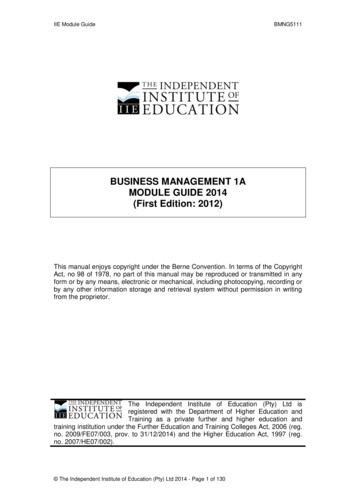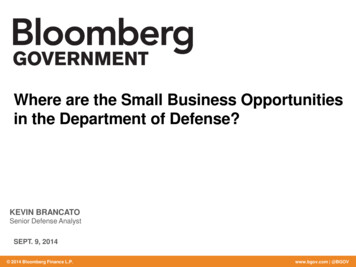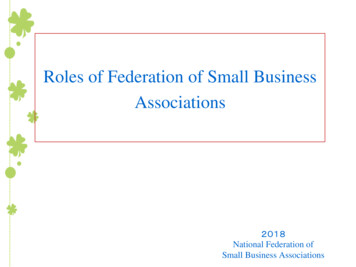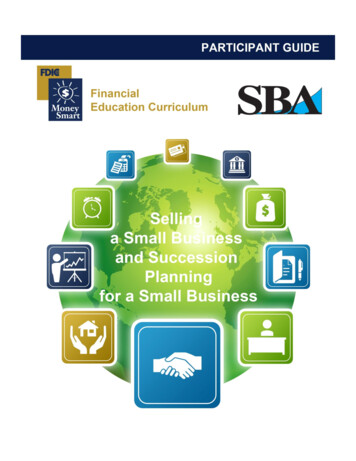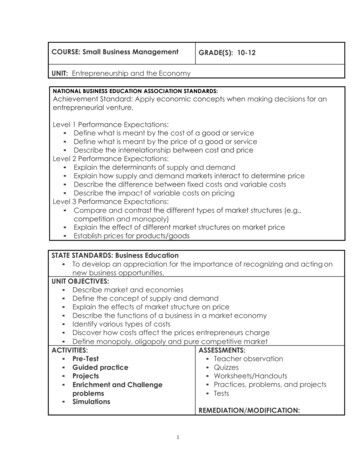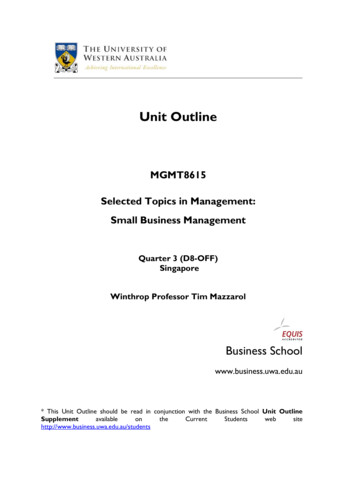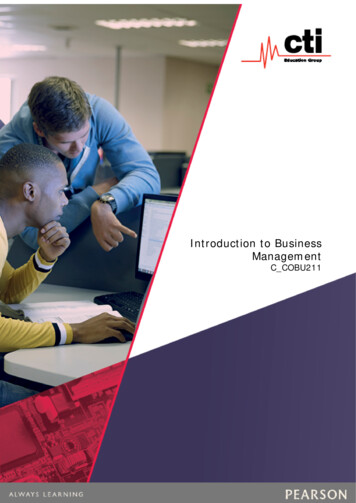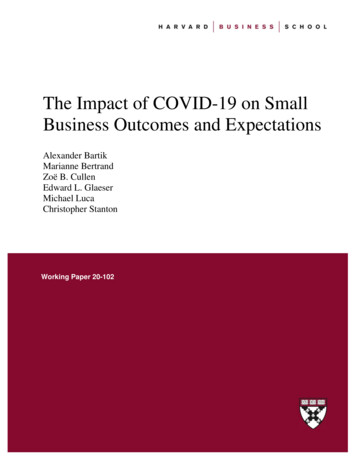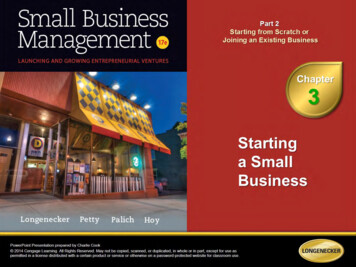
Transcription
Entrepreneurial OpportunitiesOpportunityStarting a businessBuying a businessFranchised businessFamily businessLevel of RiskHigh riskMedium riskMedium riskVariable risk
Starting a business – Anticipation/ExcitementWhat type of roller coaster do we want?We get our expectations from others . . .Perhaps less risk?A kiddie coasterOR, A thrill ride (higher risk)?Its an emotional issue –Sometimes we get out ofline at the last minute . . .
What Business To Start ?A confusing question (but it shouldn’t be):What business should I start? Think about your day-to-day life FILM (3 min)Things that you want or things that you do (everyday) Example: In 2008 Garret Camp had trouble in Paris getting acab. He thought, “Wouldn’t it be great if I could get a ride bypressing a button on my iPhone?” – Uber was born It can help to look at how (and why) others started theirbusinesses. Can check out over 1,000 ideas (fromentrepreneurs) here:http://consultapedia.com/ent int archive/why this business.php Can also take a look at the 500 most common U.S. businesseshttp://consultapedia.com/main/most common businesses.php
Components for Start-Up SuccessWhat am I passionate about?PassionNot enough by itself e.g., I love painting, but it is not enoughAbility/SkillMarketCan I become an expert?Not enough by itself e.g., I’m a great painter, but no one wants my artAre there customers for my product/service?Not enough by iteself e.g., Lots of people buy art, but maybe not my typeWe Need to Answer Four Questions1. Do we have passion, skill AND a market?2. Who is the customer?3. What need or problem are we solving?4. How will we make money?
What Type of Startup Idea is it?If you’ve ever thought of astart-up, what type was it? Existing Product Not available in their market New Ideas/ products New Technology Improved Product Perform old function in new and improved way Most common source of business start-ups
Where do New Product Ideas Come From?Most common source of new product ideasPrior nds/6%relatives5%Other4%
Business Model Matrix to Generate Business IdeasVIDEO (9 min) Steve Blank - https://steveblank.com/ Click on ‘Startup Tools’Write:List and describe (in detail) each of the 9 components of the business model
Business Model Matrix – How to UseGo to: https://goo.gl/Wh8MmTStep 1: Understand the Business Model (examine each item – 9 items)Step 2: Brainstorm and log resultsProcess:- Create/Get log file- Morning brainstorm – 15 minutes, then throughout the day- Rotate – Day 1 item #1, day 2 item # 2, day 3 item # 3,Day 10 item # 1, day 11 item # 2, day 12 item # 3, etc. [90 days ideal (each 10x)]- Evening complete log (formally)Step 3: Putting it all togetherRead and familiarize with all log entriesStarting point –Which cell of the Items (9 of them) do we consider to be our starting point of strength?Complete preliminary competitive analysis (look for subtle differences, not similarities)Put together business model
After the Business Model – How to Start The Small Business Administration (SBA) outlines ten steps to start anew business. Let’s examine each of them in detail:1. Conduct Market Research – Market research will let us know ifcustomers exist who are truly willing and able to buy our productsand services. Methods for conducting marketing research arecovered in Chapter 72. Write our Business Plan – This will be covered in Chapter 6. Weshould draft our plan because it can help to provide direction, andhelp check our assumptions. It is one of the primary documentsused to support our business loan package, and is most oftenrequired by lenders.
After the Business Model – How to Start 3. Fund Our Business – Chapter 12 will provide means andmethods for obtaining capital for our business. This will be basedon financial projections and analyses. Funding requirements for astartup business, often are obtained as an incremental process,tied to our 12 to 18-month milestones4. Select Our Business Location – A framework for locationanalysis will be provided in Chapter 9. We need to examine ourneeds for a brick and mortar facility (physical location), a virtualfacility (on-line presence), or both. Legal, regulatory and taxconsiderations are vital components that we must examine.5. Select an Appropriate Business Structure – We must identifythe type of legal structure for our business. This will be dealt within Chapter 8. Key considerations include taxation, liability,registration and reporting requirements.
After the Business Model – How to Start 6. Create Our Business Name – It is vital that our business nameeffectively communicates the type and character of our business.We must conduct research regarding the availability of ourproposed name via trademark search (Patent and TrademarkOffice: https://www.uspto.gov ) and domain searches (WHOISlookup: https://whois.icann.org ). Typically there is a localrequirement for a dba (doing business as) filing as well – Chapter87. Register Our Business Name – After we have created ourbusiness name (prior step), we need to register it with theappropriate authorities. This should include a county or staterequirement to file a dba if the company name is different than ourown. Depending upon the type of business structure, we may berequired to register with our state tax authorities (partnership, LLC,corporation, or non-profit). Optionally, we might wish to legallyprotect our name with a trademark(common law TM or registered ).
After the Business Model – How to Start 8. Obtain Federal and State Tax IDs – Get a federal employeridentification number (EIN) from the IRS through an on-line form(https://www.irs.gov). Additionally, many but not all states requirethat we obtain a state tax ID. Check with your state tax authorityfor requirements. The IRS has links to all state governmentwebsites for our convenience.9. Apply for Licenses and Permits – We need to identify local,county, state and federal license and permit requirements. Go to(http://www.calgold.ca.gov/).10. Open a Business Bank Account – Set up a bankingrelationship. A small business checking account can help youhandle legal, tax, and day-to-day issues. Also, consider setting upa revolving credit line.Source s-start-your-business/
Establish Key RelationshhipsEstablish Key Relationships:Lawyer – Help us to determine most appropriate business form (liabilitiesand taxes), licensing and regulations, contracts, intellectual property, andindustry-specific issues that might likely occur.Accountant – Assist us to review our business plan for accuracy, loan andcredit requirements, industry-specific financial trends, accounting software,and financial statement and bookkeeping setup.Banker – It is recommended that we talk with our banker after we consultwith our attorney and accountant. They can help us to ascertain businessplan inaccuracies or pitfalls, understand the loan process, analyze financialtrends, help us with key calculations.Trade Journal Editor – Industry publications (and their reporters and editor)can help us to identify industry-specific trends, competitive trends, impendinglaws and regulations, and emerging technologiesMentor – We should have several mentors (experienced people that canprovide insight and advise us). They can help us to prepare properly, reviewour plans with a critical eye, and introduce us to additional resources.Potential Investors – We should share our plans with our potential investorsprior to asking them for money. It is recommended that we invite them topartake on our advisory committee or board of directors.
Startup Process
SWOT Analysis for Start-upOpportunitiesThreatsOutside In:Opportunities & ThreatsLook at trends:Competition, Economy, Industry, Social, TechnologyInside Out:Strengths & WeaknessesLook at internal capabilities:Resources, Processes, Key Skills, PassionStrengthsWeaknessesPut it all togetherFind where these intersect – use “Business Model Matrix” resultsWe will look at:- Feasibility Analysis when we talk about Business Planning (Chapter 6)- Strategy when we talk about Pricing (Chapter 16)
SWOT Analysis for On-Going FirmModified plete in 5 days:Day 1: OpportunitiesDay 2: ThreatsDay 3: StrengthsDay 4: WeaknessesDay 5: Analysis80% on S- O20% on W- T
SWOT – Putting it all together (example)https://goo.gl/CGS9uCI developed an Interactive SWOT ToolFrom my home page,1. Click on “Entrepreneurship Resources”2. Scroll to bottom of page3. Click on “SWOT Analysis”
Practical SWOT FormatExternal Environment Social, Economic, Political,Technological, Competitive TrendsWhat do these “uncontrollables” look like?Lets look at Opportunities first:1.What are some new and emerging technologies that can help yourbusiness (explain)?2.Which portion of the economy is growing that can help yourbusiness (industries)?3.What are interest rate/inflation trends and how might yourbusiness gain by them?4.What are new government regulations (certification requirements)that may benefit your particular business?5.What are current demographic trends (income levels,employment) and how might they help your particular business?
Practical SWOT FormatExternal Environment Social, Economic, Political,Technological, Competitive TrendsWhat do these “uncontrollables” look like?Lets look at Threats now:1.What are some new and emerging technologies that can hurt yourbusiness (explain)?2.Which portion of the economy is shrinking/contracting that canhurt your business (industries)?3.What are interest rate/inflation trends and how might yourbusiness get hurt by them?4.What are new government regulations (certification requirements)that may harm your particular business?5.What are current demographic trends (income levels,employment) and how might they hurt your particular business?
Practical SWOT FormatCSF Critical Success Factors – also called KSIWhat must we do, and do well, to survive and thrivein this business?Lets look at Strengths now:1.What do you do well (that you must do well) in order tosurvive and thrive in your business?How do you measure each of these skills (if not currentlymeasuring, how will you measure them)?2.Describe the types of customers you match the best(the ones you can service the best)?3.With which vendors do you have the best relationship?4.Which results, that you measure each month, wouldyou consider to be your greatest strengths?
Practical SWOT FormatCSF Critical Success FactorsWhat must we do, and do well, to survive and thrivein this business?Lets look at Weaknesses now:1.What do you NOT do well (but you must do well) in order tosurvive and thrive in your business?How do you measure each of these skills (if not currently measuring,how will you measure them)?2.Describe the types of customers you match the least (the onesyou can least service properly)?3.With which vendors should you have a strong relationship, butdon’t?4.Which results, that you measure each month, would you considerto be your greatest weaknesses?
SWOT – Putting it all together (example)An example from my company
SWOT – Putting it all together (example)An example from my company
Release Form for BUSM 66 ProjectPlease complete thetop of the Release FormOnly put in yourLast NameFirst NamePlease sign at thebottom of the formAND sign on thereverse side
Entrepreneur Interview –ProjectHandout on Entrepreneur Interview Project Review the steps for project completion (first page) Sign “Release Form” Access files for project CourPage.htmEntrepreneur Interview Instructions (txt) (Right click and "Save Target As .")Entrepreneur Interview On-Line Form Work on/ edit your content (paper then txt file) Complete the project by entering into on-line form
What type of roller coaster do we want? We get our expectations from others . . . Perhaps less risk? A kiddie coaster OR, A thrill ride (higher risk)? Its an emotional issu
